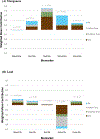Assessing the contributions of metals in environmental media to exposure biomarkers in a region of ferroalloy industry
- PMID: 30337680
- PMCID: PMC6472994
- DOI: 10.1038/s41370-018-0081-6
Assessing the contributions of metals in environmental media to exposure biomarkers in a region of ferroalloy industry
Abstract
Residential proximity to ferroalloy production has been associated with increased manganese exposure, which can adversely affect health, particularly among children. Little is known, however, about which environmental samples contribute most to internal levels of manganese and other ferroalloy metals. We aimed to characterize sources of exposure to metals and evaluate the ability of internal biomarkers to reflect exposures from environmental media. In 717 Italian adolescents residing near ferromanganese industry, we examined associations between manganese, lead, chromium, and copper in environmental samples (airborne particles, surface soil, indoor/outdoor house dust) and biological samples (blood, hair, nails, saliva, urine). In multivariable regression analyses adjusted for child age and sex, a 10% increase in soil Mn was associated with increases of 3.0% (95% CI: 1.1%, 4.9%) in nail Mn and 1.6% (95% CI: -0.2%, 3.4%) in saliva Mn. Weighted-quantile-sum (WQS) regression estimated that higher soil and outdoor dust Mn accounted for most of the effect on nail Mn (WQS weights: 0.61 and 0.22, respectively, out of a total of 1.0). Higher air and soil Mn accounted for most of the effect on saliva Mn (WQS weights: 0.65 and 0.29, respectively). These findings can help inform biomarker selection in future epidemiologic studies and guide intervention strategies in exposed populations.
Keywords: Chromium; Copper; Ferroalloy; Lead; Manganese; Weighted quantile sum regression.
Conflict of interest statement
Figures



Similar articles
-
Associations of a Metal Mixture Measured in Multiple Biomarkers with IQ: Evidence from Italian Adolescents Living near Ferroalloy Industry.Environ Health Perspect. 2020 Sep;128(9):97002. doi: 10.1289/EHP6803. Epub 2020 Sep 8. Environ Health Perspect. 2020. PMID: 32897104 Free PMC article.
-
Impact of ferromanganese alloy plants on household dust manganese levels: implications for childhood exposure.Environ Res. 2015 Apr;138:279-90. doi: 10.1016/j.envres.2015.01.019. Epub 2015 Mar 4. Environ Res. 2015. PMID: 25747819 Free PMC article.
-
Integrated measures of lead and manganese exposure improve estimation of their joint effects on cognition in Italian school-age children.Environ Int. 2021 Jan;146:106312. doi: 10.1016/j.envint.2020.106312. Epub 2020 Dec 10. Environ Int. 2021. PMID: 33395951 Free PMC article.
-
Biomarkers of environmental manganese exposure.Crit Rev Toxicol. 2022 Apr;52(4):325-343. doi: 10.1080/10408444.2022.2095979. Epub 2022 Jul 27. Crit Rev Toxicol. 2022. PMID: 35894753 Review.
-
A Review on the Environmental Exposure to Airborne Manganese, Biomonitoring, and Neurological/Neuropsychological Outcomes.Rev Environ Contam Toxicol. 2021;254:85-130. doi: 10.1007/398_2020_46. Rev Environ Contam Toxicol. 2021. PMID: 32474705 Review.
Cited by
-
Animal Models of Childhood Exposure to Lead or Manganese: Evidence for Impaired Attention, Impulse Control, and Affect Regulation and Assessment of Potential Therapies.Neurotherapeutics. 2023 Jan;20(1):3-21. doi: 10.1007/s13311-023-01345-9. Epub 2023 Feb 28. Neurotherapeutics. 2023. PMID: 36853434 Free PMC article. Review.
-
Multi-media biomarkers: Integrating information to improve lead exposure assessment.Environ Res. 2020 Apr;183:109148. doi: 10.1016/j.envres.2020.109148. Epub 2020 Jan 20. Environ Res. 2020. PMID: 32004829 Free PMC article.
-
Manganese transporter genetics and sex modify the association between environmental manganese exposure and neurobehavioral outcomes in children.Environ Int. 2019 Sep;130:104908. doi: 10.1016/j.envint.2019.104908. Epub 2019 Jun 22. Environ Int. 2019. PMID: 31233999 Free PMC article.
-
Environmental tobacco smoke exposure is associated with increased levels of metals in children's saliva.J Expo Sci Environ Epidemiol. 2023 Nov;33(6):903-910. doi: 10.1038/s41370-023-00554-w. Epub 2023 May 5. J Expo Sci Environ Epidemiol. 2023. PMID: 37147431 Free PMC article.
-
Short- and long-term exposure to trace metal(loid)s from the production of ferromanganese alloys by personal sampling and biomarkers.Environ Geochem Health. 2022 Dec;44(12):4595-4618. doi: 10.1007/s10653-022-01218-8. Epub 2022 Feb 22. Environ Geochem Health. 2022. PMID: 35190915 Free PMC article.
References
-
- Carrizales L, Razo I, Tellez-Hernandez JI, Torres-Nerio R, Torres A, Batres LE, et al. Exposure to arsenic and lead of children living near a copper-smelter in San Luis Potosi, Mexico: Importance of soil contamination for exposure of children. Environ Res 2006;101(1):1–10. - PubMed
-
- Torres-Agustin R, Rodriguez-Agudelo Y, Schilmann A, Solis-Vivanco R, Montes S, Riojas-Rodriguez H, et al. Effect of environmental manganese exposure on verbal learning and memory in Mexican children. Environ Res 2013;121:39–44. - PubMed
Publication types
MeSH terms
Substances
Grants and funding
LinkOut - more resources
Full Text Sources

